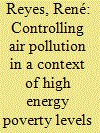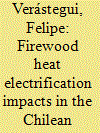|
|
|
Sort Order |
|
|
|
Items / Page
|
|
|
|
|
|
|
| Srl | Item |
| 1 |
ID:
162906


|
|
|
|
|
| Summary/Abstract |
Firewood is the main fuel used for heating in Chile, but its inefficient use is producing severe episodes of air pollution. To address this issue, authorities implement Air Pollution Management Plans (PDAs), which include actions such as setting moisture requirements for firewood, replacing old wood-stoves, temporarily banning the use of firewood, and improving homes´ thermal insulation. However, PDAs do not focus on nor do they prioritize measures in relation to specific social contexts. This study assessed socio-economic variables, energy consumption and indoor environments in households located in the city of Valdivia, through surveys and the monitoring of temperatures and indoor air pollution levels. We found that, during the winter months, 68% of the time living room temperatures were below 21 °C, and PM2.5 concentrations were above international standards. Furthermore, over 61% of households were to suffer a state of energy poverty. We urge decision-makers to consider social inequalities and energy consumption patterns in cities with high firewood consumption, prioritizing measures and focusing resources on reducing both air pollution and energy poverty. Thermal insulation of homes should be a priority in mid-to-low-income families, since these have the highest levels of energy demand. Other PDA´s measures could be economically regressive in these social-strata.
|
|
|
|
|
|
|
|
|
|
|
|
|
|
|
|
| 2 |
ID:
177147


|
|
|
|
|
| Summary/Abstract |
Prime objective of this study is to analyze fuel consumption patterns at national as well as at provincial level for Pakistan. Dynamic patterns in household fuel choices have been examined under Two-Stage Budgeting Framework through Quadratic Approximation of Almost Ideal Demand System (QUAIDS) using HIES data for year 2015–16 to obtain reliable estimates of Price and Budget Elasticities. Quadratic Engel estimates reflect households’ energy expenditures allocation decisions while the Probit estimates explore how alternate fuels are chosen by households for consumption? The Engel estimates highlight that the share of fuel expenditures in total household expenditures is higher in rural areas than in urban areas. The computed compensated price elasticities suggest that Firewood and Kerosene are relatively more price inelastic in rural areas as compared to the urban areas. Furthermore, our estimates also indicate that cleaner fuels are more price inelastic in urban areas than in rural areas with inter-provincial variations in computed elasticities. These estimates can be used as an effective policy making tool for transition towards cleaner fuels, energy policy simulations, to evaluate taxation and subsidy frameworks and energy system forecasting to prevent environmental degradation.
|
|
|
|
|
|
|
|
|
|
|
|
|
|
|
|
| 3 |
ID:
133027


|
|
|
|
|
| Publication |
2014.
|
| Summary/Abstract |
In 1998, the South African government developed an energy policy that focused on a pro-poor agenda. Its objectives included addressing the health impacts of solid fuel use in households. Fourteen years later, and with household electrification at over 80%, millions still use solid fuels and yet ambitious policy objectives to address this situation are not being met. Using three theoretical frameworks; institutional capacity, policy inheritance and the symbolic use of policy, this paper analyses the reasons why household energy policy objectives related to solid fuels and health, as stated in the 1998 South African energy policy, have not been implemented. The results of the analysis show that the symbolic use of policy, including meanings of objects used for meeting policy objectives is the most critical explanation. The paper illustrates that political and historical contexts are critical to understanding policy outcomes in developing and transition countries which often experience tensions between implementing what may seem as objective policies, and that matches their political and historical experiences and aspirations. We recommend that policy analysts in the energy sector complement currently common methods to include political contexts of policy development and implementation in order to better understand why policy makers chose to implement certain policies over others.
|
|
|
|
|
|
|
|
|
|
|
|
|
|
|
|
| 4 |
ID:
176843


|
|
|
|
|
| Summary/Abstract |
Chile presents an extended use of low-quality firewood for residential heating. This raises serious concerns, mainly related to health problems due to particulate emissions from firewood combustion. Several initiatives have been considered by the Chilean government to address this, including heat electrification goals. In addition, the Chilean power system is undergoing a decarbonization process. This paper analyzes the impacts of firewood heat electrification over the Chilean power system’s decarbonization process until 2044, based on a capacity expansion planning model and an estimation of firewood heat demand, to account for major changes in load shape and spatial distribution. The results show that there is a large increase in the power system total cost (ranging from 5.6% to 19.4%), with flexibility requirements becoming larger in the south. Technologies that strongly depend on local resource availability, such as wind and concentrated solar power, present changes in their systemic value, altering the need for storage and flexibility. Also, aspects such as household insulation, electrification efficiency, and smart heating technologies would significantly impact the process in terms of cost reduction and optimal generation mix. The policy implications for the Chilean power system are presented, within the broader discussion of the overall firewood problem.
|
|
|
|
|
|
|
|
|
|
|
|
|
|
|
|
| 5 |
ID:
126564


|
|
|
|
|
| Publication |
2013.
|
| Summary/Abstract |
Cities in the central-southern area of Chile face serious environmental pollution due to extensive use of firewood for heating. Low energy efficiency of constructions and cold climate increase the problem, which also affects native forests. The aims of this study are to characterize energy consumption in dwellings of this region, investigate the reduction potential, and study social and environmental consequences of high consumption of firewood. Actual energy consumption is studied with information from surveys, potential for reduction is modeled with software and other consequences are analyzed from previous studies. Results for the city of Valdivia show high firewood consumption per household, with a media bulk volume near 12 m3/year. Thermal regulations are softer compared with other countries. Moreover, around 85% of buildings were built before enforcing codes in 2007, and has almost no thermal protection. The reduction potential due to thermal improvements is found to be very high (62%) if buildings are refurbished to comply with the present Chilean Norm of 2007, but it reaches a 77% reduction if refurbished according to stricter foreign regulations. Therefore, an energy efficiency program strongly addressing existing buildings has the largest potential for reducing firewood use, and therefore mitigate environmental and health impacts.
|
|
|
|
|
|
|
|
|
|
|
|
|
|
|
|
|
|
|
|
|